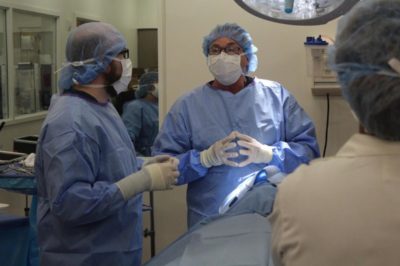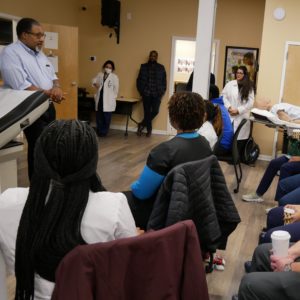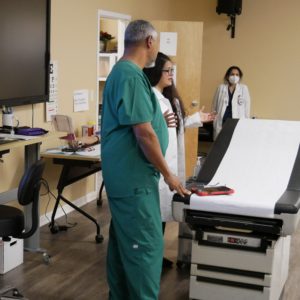Gurneys were being wheeled in and the rhythmic sound of a heart monitor filled the room as nurses prepared a patient for to see a doctor. From gunshot wounds to patients that suffered from schizophrenia, all four beds, commonly known as bays, continued to be filled and replaced by other patients on Tuesday at Philadephia College of Osteopathic Medicine in Suwanee.
While the intensity was real, the outcome was predetermined, as PCOM hosted Trauma Day, which tasked nurses from Georgia Gwinnett College, emergency medical technicians from Gwinnett Technical College and future doctors from PCOM to work together through 24 different scenarios, from getting the patient off the ambulance all the way to the operating room.
Plans for Trauma Day have been going for months, with Michael Sampson, associate professor of family medicine and sports medicine, saying PCOM would be interested in hosting it.
“We love to showcase our campus and simulation room,” Sampson said. “It’s multifaceted with the EMTs for Gwinnett Tech, nurses from GGC and our DOs (doctors of osteopathic medicine) here. And our $3.5 million simulation room can handle all of the stuff going on.”
Previously, the event had been held at GGC and was slated to go to Gwinnett Tech, but plans changed.
“The last time we had Trauma Day over at Georgia Gwinnett College, we put in a plans initially at Gwinnett Tech, but our simulation director recommended we do them here,” Sampson said. “Before he stopped talking, I immediately agreed to do this.”
The 24 simulations that students participated in throughout the day were selected by students seeking their master’s degrees in biomedical sciences. Each simulation tested students from how they interact with a patient to the proper procedure for diagnosing a situation.
For Sampson, the biggest takeaway he wanted PCOM students to get was to make sure they worked with others as a team.
“As physicians, we can do a lot,” he said. “We can’t do it all, and rely on EMTs and nurses to help out. When they go out in the real world, they have the attitude of we’re one big team.”
Alisha Adams, Gwinnett Tech lead instructor for advanced EMT students, said Trauma Day is very important for students.
“It’s critical because our students normally do scenarios in-house with adjuncts they know,” Adams said. “Here, they interact with people that they don’t know and also get debriefed about their patients, something that doesn’t happen.”
The ability to see the entire process from start to finish is something she believes provides value to students.
“It keeps getting better and better each year,” Adams said. “We allow the students to come full circle with the patient process.”
EMTs were required during the process to wheel in patients on gurneys and give the nurses that were waiting in a triage room a basic report on the patient before taking the patient into the simulation room.
The program then transferred to nurses delving deeper into possible issues before the doctors arrived.
“Today has been about looking at three different components of nursing,” said Sharon Grason, GGC director of nursing. “Communication, collaboration and curing are what we we’re looking for today.”
Grason said the more times nursing students are able to have interprofessional interactions, the better clinicians the students become.
Likewise, Sampson said that Trauma Day has become a huge success for all students that participate, and plans on including PCOM’s pharmacy and physical therapy programs.
“They’re afraid of what they don’t know right now,” Sampson said. “But they’re a lot more prepared for situations in the real world compared to those that don’t participate.”
This article was originally published on Gwinnett Daily Post



